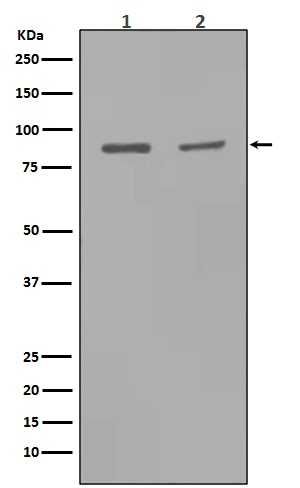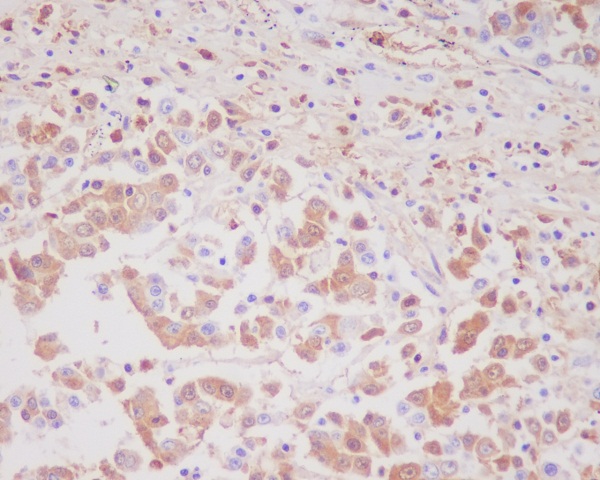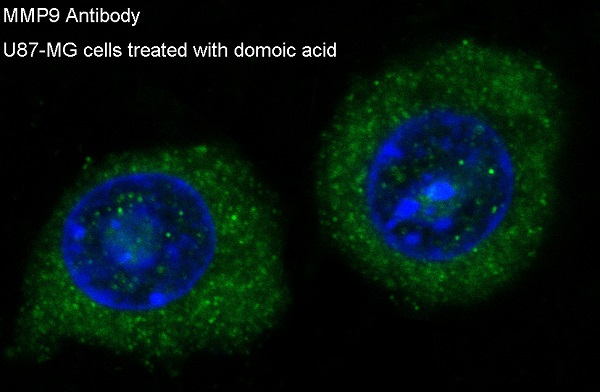Anti-MMP9 Rabbit Monoclonal Antibody
- SPECIFICATION
- CITATIONS
- PROTOCOLS
- BACKGROUND

Application
| WB, IHC, IF, ICC, FC |
|---|---|
| Primary Accession | P14780 |
| Host | Rabbit |
| Isotype | Rabbit IgG |
| Reactivity | Rat, Human |
| Clonality | Monoclonal |
| Format | Liquid |
| Description | Anti-MMP9 Rabbit Monoclonal Antibody . Tested in WB, IHC, ICC/IF, Flow Cytometry applications. This antibody reacts with Human, Rat. |
| Gene ID | 4318 |
|---|---|
| Other Names | Matrix metalloproteinase-9, MMP-9, 3.4.24.35, 92 kDa gelatinase, 92 kDa type IV collagenase, Gelatinase B, GELB, 67 kDa matrix metalloproteinase-9, 82 kDa matrix metalloproteinase-9, MMP9, CLG4B |
| Calculated MW | 78458 MW KDa |
| Application Details | WB 1:500-1:2000 IHC 1:50-1:200 ICC/IF 1:50-1:200 FC 1:50 |
| Subcellular Localization | Secreted, extracellular space, extracellular matrix. |
| Tissue Specificity | Produced by normal alveolar macrophages and granulocytes. |
| Contents | Rabbit IgG in phosphate buffered saline, pH 7.4, 150mM NaCl, 0.02% sodium azide and 50% glycerol, 0.4-0.5mg/ml BSA. |
| Clone Names | Clone: BCD-13 |
| Immunogen | A synthesized peptide derived from human MMP9 |
| Purification | Affinity-chromatography |
| Storage | Store at -20°C for one year. For short term storage and frequent use, store at 4°C for up to one month. Avoid repeated freeze-thaw cycles. |
| Name | MMP9 |
|---|---|
| Synonyms | CLG4B |
| Function | Matrix metalloproteinase that plays an essential role in local proteolysis of the extracellular matrix and in leukocyte migration (PubMed:12879005, PubMed:1480034, PubMed:2551898). Could play a role in bone osteoclastic resorption (By similarity). Cleaves KiSS1 at a Gly-|-Leu bond (PubMed:12879005). Cleaves NINJ1 to generate the Secreted ninjurin-1 form (PubMed:32883094). Cleaves type IV and type V collagen into large C-terminal three quarter fragments and shorter N- terminal one quarter fragments (PubMed:1480034). Degrades fibronectin but not laminin or Pz-peptide. |
| Cellular Location | Secreted, extracellular space, extracellular matrix |
| Tissue Location | Detected in neutrophils (at protein level) (PubMed:7683678). Produced by normal alveolar macrophages and granulocytes. |

Thousands of laboratories across the world have published research that depended on the performance of antibodies from Abcepta to advance their research. Check out links to articles that cite our products in major peer-reviewed journals, organized by research category.
info@abcepta.com, and receive a free "I Love Antibodies" mug.
Provided below are standard protocols that you may find useful for product applications.
If you have used an Abcepta product and would like to share how it has performed, please click on the "Submit Review" button and provide the requested information. Our staff will examine and post your review and contact you if needed.
If you have any additional inquiries please email technical services at tech@abcepta.com.













 Foundational characteristics of cancer include proliferation, angiogenesis, migration, evasion of apoptosis, and cellular immortality. Find key markers for these cellular processes and antibodies to detect them.
Foundational characteristics of cancer include proliferation, angiogenesis, migration, evasion of apoptosis, and cellular immortality. Find key markers for these cellular processes and antibodies to detect them. The SUMOplot™ Analysis Program predicts and scores sumoylation sites in your protein. SUMOylation is a post-translational modification involved in various cellular processes, such as nuclear-cytosolic transport, transcriptional regulation, apoptosis, protein stability, response to stress, and progression through the cell cycle.
The SUMOplot™ Analysis Program predicts and scores sumoylation sites in your protein. SUMOylation is a post-translational modification involved in various cellular processes, such as nuclear-cytosolic transport, transcriptional regulation, apoptosis, protein stability, response to stress, and progression through the cell cycle. The Autophagy Receptor Motif Plotter predicts and scores autophagy receptor binding sites in your protein. Identifying proteins connected to this pathway is critical to understanding the role of autophagy in physiological as well as pathological processes such as development, differentiation, neurodegenerative diseases, stress, infection, and cancer.
The Autophagy Receptor Motif Plotter predicts and scores autophagy receptor binding sites in your protein. Identifying proteins connected to this pathway is critical to understanding the role of autophagy in physiological as well as pathological processes such as development, differentiation, neurodegenerative diseases, stress, infection, and cancer.




